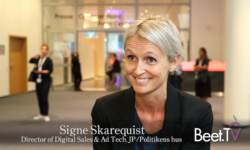It is the number-nine news organization in the United States, with 52 million monthly uniques and 11 million social followers.
But, like any local news company, the challenge for Advance Local is piecing together its network of local strengths in to something that has both scale and on-the-ground relevance.
To date, Advance Local has made a good fist of selling digital ads using the array of programmatic tools available.
But, as we approach the end of 2018, for Advance Local’s Jeff Sutton, we are also approaching the end of one chapter in the programmatic era.
“We’re an early advocate of creating transparency in our auctions and doing it in such a way to allow the advertiser to find maximum value in the impression that we’re selling,” says Advanced Local’s VP programmatic and ad-tech revenue strategy in this video interview with Beet.TV.
“But I think we’re coming to the end of that. We’re moving into a place where identity management and attribution management around a consumer journey … is sort of the next big frontier that we have to move to.”
Digital development
In a summer update, the company’s CEO cited growing digital ad revenue, an upcoming metered paywall at its Syracuse operation and a huge viideo view count.
“The biggest hurdle we face remains how fast can we adjust our business strategies to deal with the latest headwinds, whether it’s the devaluation of journalism in Facebook’s audience algorithms or financially onerous tariffs on Canadian newsprint, which we rely on heavily,” Randy Siegel wrote.
“Even our impressive growth in video views has been compromised by the economics of YouTube’s advertising platform, which favors national publishers instead of local ones – and has hurt our ability to monetize the video audience many of you have worked so hard to build.”
Toward the audience
The move from a user-centered approach to online ad selling, in which inventory is shown to a user based on available real-time cues, to one that is based around a holistic understanding of that person, regardless of the device she is using, was already a trend that is in-play.
Moves like GDPR have been just one of the drivers behind the change. Another is the increasing arrival of CRM data and big marketing software in the advertising mix.
And Sutton is swimming in the same direction.
“We’re very much thinking about creating a pool of logged in users, as opposed to a pool of audience, to be able to enrich the data that we gather from our readers and to make it more immediately actionable to advertisers,” he adds. “[It’s about] being able to understand not just that we have a user with a cookie, but actually a user with a identity that’s understood, not just on our site, but across the internet.
“Increasingly, [advertisers] don’t want to know that we have a reader with a cookie, they want to know that we have a reader who has a specific, who is a specific human being behind the device. And that demand is driving very much of a re-think from our point of view in terms of how we organize our business.”
This video is part of a series primarily produced at DMEXCO 2018 in Cologne titled: “Finding Success in a Time of Transformation.” It is is presented by PubMatic. For segments from the series, please visit this page.





































